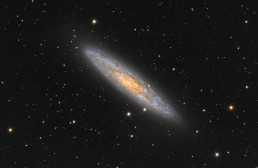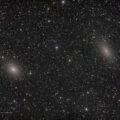NGC 253 is one of the brightest visible spiral galaxies, but also one of the most dusty. It is often called a Silver Coin galaxy due to its look in the smaller telescopes, and more formally, it is called Sculptor Galaxy, because it is located in the constellation of Sculptor.
The galaxy was discovered by Caroline Herschel in 1783 during one of her systematic comet searches. Many years later, John Herschel observed it using his 18-inch reflector, and he wrote: “very bright and large (24′ in length); a superb object…. Its light is somewhat streaky, but I see no stars in it except 4 large and one very small one, and these seem not to belong to it, there being many near…“.
Sculptor Galaxy is considered one of the most easily viewed spiral galaxies in the sky after the Andromeda Galaxy. In the larger telescopes mottled galaxy disc can be observed, and also a dark dust lane northwest of the nucleus. NGC 253 is located about 11 million light-years from us in the center of the Sculptor Group, one of the nearest groups of galaxies to the Milky Way. The group is so close that other members are scattered in other constellations, like NGC 247 in Cetus or NGC 625 in Phoenix.
Imaging the Silver Coin galaxy from the northern hemisphere is a bit of a challenge, because its declination is significantly below the celestial equator. The picture above was captured in Cyprus, where the galaxy is already a bit higher, but the conditions were far from perfect. High humidity and clouds were present, but due to the large galaxy brightness, the overall outcome is somewhat satisfying.
Image technical data: Date: August 2025 Location: Northern Cyprus Telescope: TS CF-APO 80/480 Corrector: TS FF/FR 0.8x Camera: QHY miniCAM8 Mount: AM3 Guiding: ASI224 + SV165 Exposures: LRGB 160:50:40:40 minutes Conditions: Bortle 4-5, transparency and seeing medium






